Bad Homburg digitizes treasures: 17,000 exhibits accessible online!
The historical museum in Bad Homburg is digitizing its exhibits to make cultural assets more accessible.

Bad Homburg digitizes treasures: 17,000 exhibits accessible online!
An ambitious project to digitize the extensive collections is being pushed forward in the municipal historical museum of Bad Homburg. Over 17,000 exhibits are already available on the museum-digital.de platform, enabling experts and museum lovers to access historical knowledge more easily. Who would have thought that so much history was just a click away?
A special highlight is a historical children's drop hat from the Baroque period, which was elaborately decorated with silver threads and sequins. This hat, which was made for small children around 1700, is now part of the digital exhibition. The digitization of such works of art not only makes the collection easier to find, but also opens up new perspectives on our cultural treasures. According to the German Museum Association, digital recording represents an opportunity to ensure the future viability of museums: “The digital transformation affects all areas of museum operations,” say the Museum Association experts.
Insight into the digital future
The project to digitize the Bad Homburg collections is benefiting significantly from the current closure of the Horex Museum as well as the extensive renovation of the Gothic House, which has already been underway for five years. What may seem like negative circumstances at first glance turns out to be an opportunity to carry out a comprehensive inventory and digital recording. "We firmly believe that digitalization is more than just a trend. It will be the language of the future for our museums," says a report from Technavigator.
With the aim of transferring almost all 40,000 exhibits, including the planned exhibitions, such as a sculpture show with works by Rainer Hunold, to digital, the Gothic House is expected to open in late summer. The exterior construction work has been completed, but the interior is still waiting for the finishing touches. The visitors still need a bit of patience - the building inspection is delayed due to a lack of doors and sockets.
New ways of interaction and education
Digitalization not only offers new opportunities for collection work, but also for interaction with the audience. Thanks to digital strategies, cultural heritage can not only be better managed and presented, but can also be experienced by a wider audience. Interactive and multimedia presentations open up new avenues for museum educational work. Virtual tours and augmented reality – these are just some of the tools that offer visitors immersive experiences.
However, the challenges that come with digitalization should not be underestimated. “A good knack for digital strategies and the right technical infrastructure are essential,” report the experts. Support through cultural funding and the development of community platforms are essential to promote visitor participation. The younger generations in particular can be integrated even more closely into museum life.
Overall, it shows that digitalization is more than just a necessity - it is an opportunity that opens the doors to new worlds. The Bad Homburg Museum is an example of this change, which will enrich the cultural landscape. If everything goes well, we may soon be able to look forward to virtually exploring the baroque beauties!
For further information about the digitization projects, those interested can visit the pages of the Deutscher Museumsbund and Technavigator. And of course it's also worth taking a look at the Bad Homburg Museum's collection on [museum-digital.de](https://www.fnp.de/lokales/hochtaunus/bad-homburg-ort47554/bad-homburger-museumsstuecke- Werden-nach-und-nach-digitaliert-und-besser-auffindbar-93784142.html)!

 Suche
Suche
 Mein Konto
Mein Konto